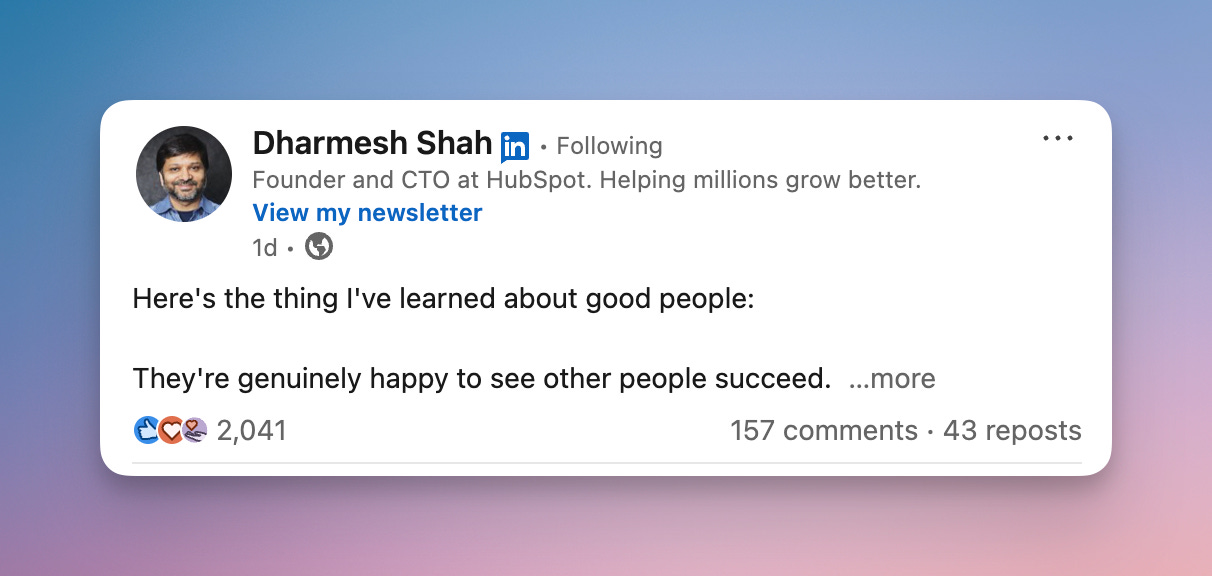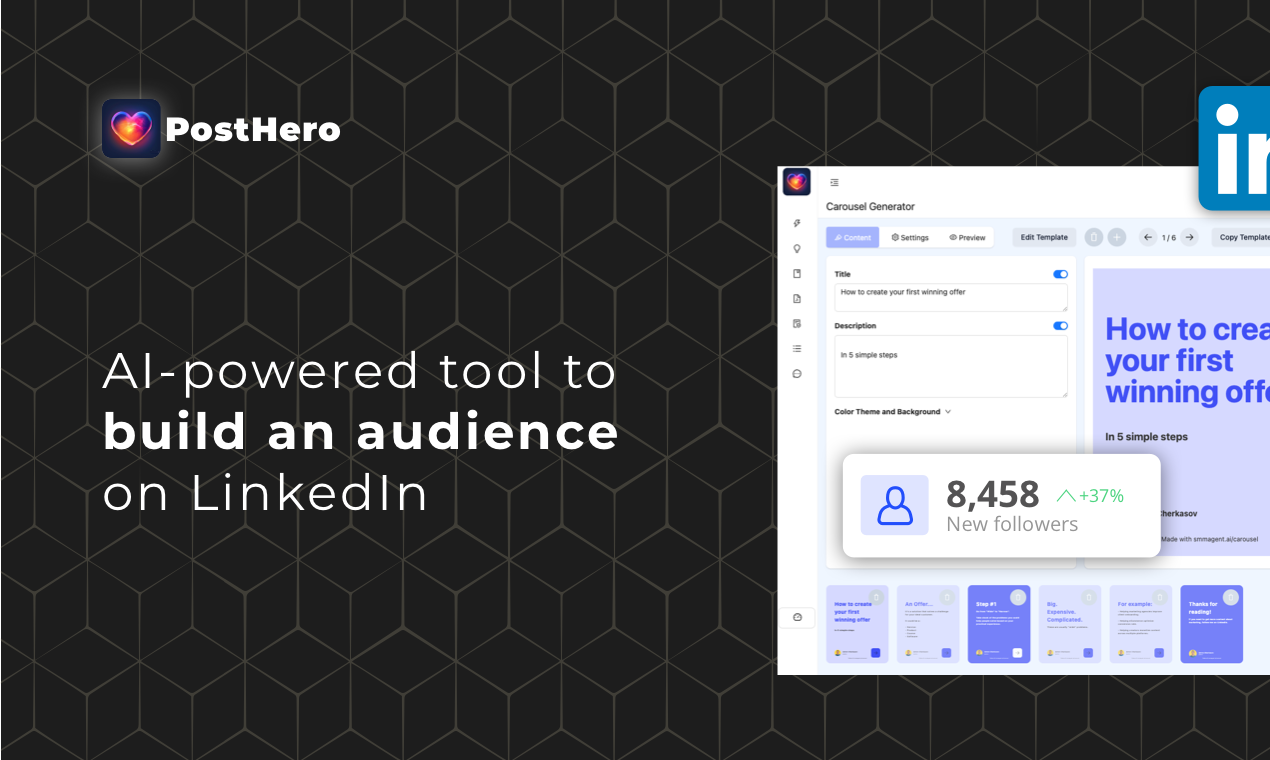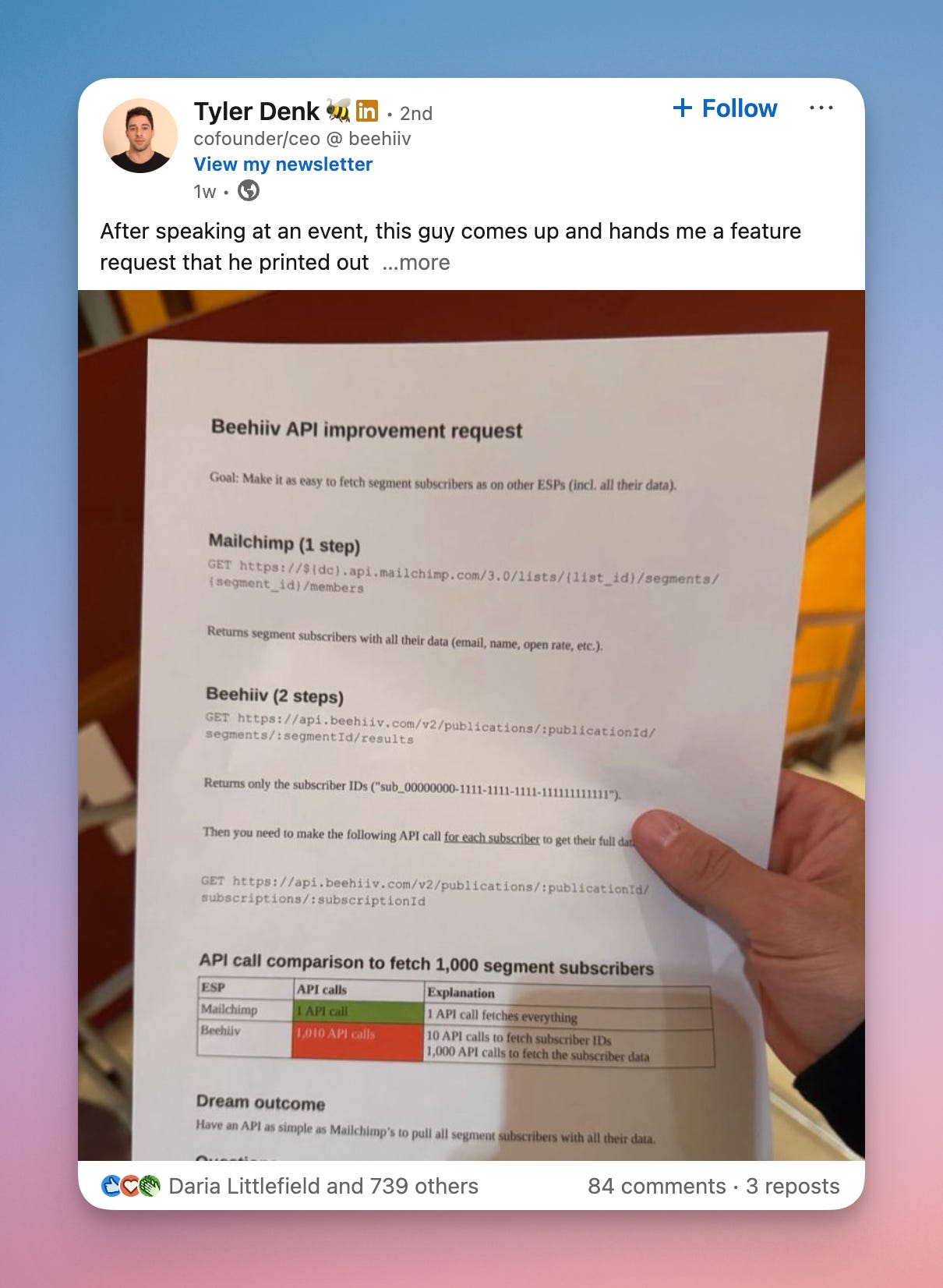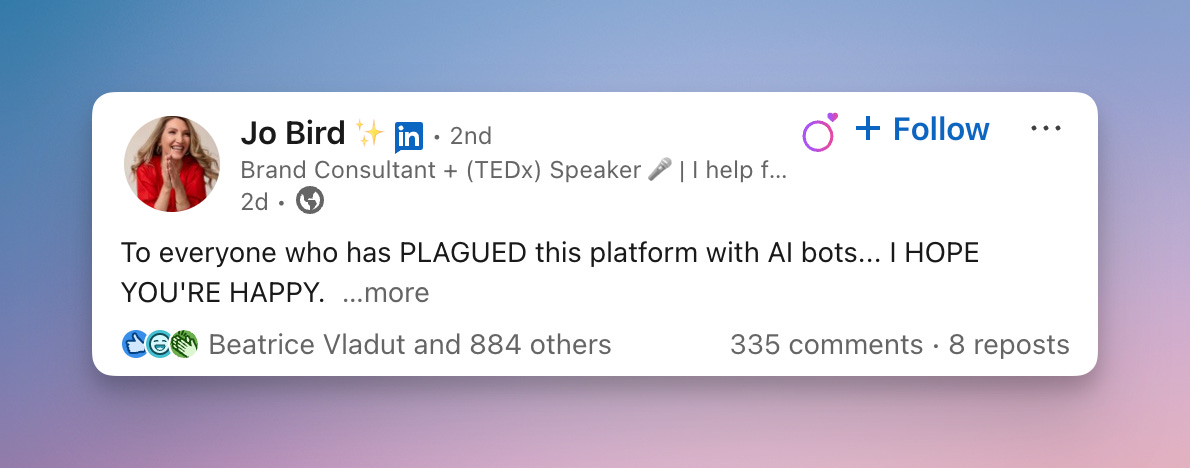LS #63: How to Write LinkedIn Hooks That Attract Buyers (Not Browsers)
We got 0 bookings on LinkedIn. Then I changed one thing about hooks and we started booking 2-3 demos per week.
Hi there,
I analyze top LinkedIn posts to teach you how to write content that connects.
In this issue, you’ll find:
The 3 high-performing LinkedIn posts this week
How to write LinkedIn hooks that attract buyers (not browsers)
The 3 high-performing posts this week
1. Here’s the thing I’ve learned about good people:
Why this post?
This post went viral, receiving 2k likes in a day. It received 9-31 times more engagement and views than Dharmesh’s posts this week.
WHY THIS POST WENT VIRAL
This post worked because it exposed a painful truth everyone recognizes but rarely discusses openly: many people struggle to be genuinely happy when their friends succeed.
BREAKDOWN
Simple wisdom hook: “Here’s the thing I’ve learned about good people:” - positions it as earned insight
One clear principle: States a single, powerful observation rather than listing multiple points
Minimalist approach: Entire post is just three sentences - lets the message speak for itself
TOGETHER WITH POSTHERO
Grow your audience faster on LinkedIn. With an AI-powered tool that helps you create content and grow on LinkedIn.
Create high-converting content that helps you grow on LinkedIn
Create a weekly content in 76 seconds
AI Voice assistant for creating content in seconds
2. After speaking at an event, this guy comes up and hands me a feature request that he printed out
Why this post?
Another post that went viral this week—it got 740 likes in a week and performed 4-14 times better than Tyler’s other posts this week.
BREAKDOWN:
Unusual customer behavior: “this guy comes up and hands me a feature request that he printed out” - immediately unusual
Photo proof: Shows actual printed document with detailed API comparison and technical specs
Competitor comparison: Shows exactly how Mailchimp does it better with concrete examples
Visual evidence of effort: Color-coded comparison chart (green vs red) shows professional preparation
Humble founder moment: CEO publicly acknowledging customer feedback shows accessibility
3. To everyone who has PLAGUED this platform with AI bots... I HOPE YOU’RE HAPPY.
Why this post?
This post performed 3.5-10 times better than Jo’s other posts this week.
WHY THIS POST WENT VIRAL
This post captured widespread frustration about AI-generated content flooding LinkedIn while being funny and clever enough to share.
BREAKDOWN:
Aggressive hook: “To everyone who has PLAGUED this platform with AI bots... I HOPE YOU’RE HAPPY” - all caps shows real anger
Sarcastic well-wishes: “I want you all to be millionaires. Living on a yacht. Without a care in the world.” - clearly doesn’t mean it
Brutal punchline: “Because at least then the pointlessness of your parroting will be somewhat worth it” - explains the sarcasm
Clear sides established: Sets up “AI bot users” vs. “the rest of us who actually enjoy using our brains to think”
Mocking future: “I look forward to reading your generic comments” - calls out the predictable AI-generated responses
Bot trap inclusion: Lists random words (Elephant, Bumfuzzle, Purple, Lollypop, Sparkle Juice) to catch AI comments
HOW TO CREATE YOUR OWN POST:
Express real frustration: Don’t hold back on calling out behavior that genuinely annoys you
Use sarcasm effectively: Say the opposite of what you mean to make your point hit harder
Create clear villains: Make it obvious who you’re criticizing and why they’re wrong
Include clever traps: Add elements that will expose the behavior you’re criticizing
Balance anger with humor: Be mad enough that people take you seriously but funny enough they share it
LinkedIn Guide
How to write LinkedIn hooks that attract buyers (not browsers)
I spent 3 months writing LinkedIn posts that got massive engagement for my client.
Thousands of views. Hundreds of likes and comments. His profile stats skyrocketed.
But his calendar stayed empty.
Then I changed one thing about hooks and we started booking 2-3 demos per week.
Here’s what I learned: The hook that stops scrollers isn’t the same hook that stops buyers.
The Hook Problem
What most founders do:
Write hooks designed to get clicks
Use curiosity gaps and cliffhangers
Appeal to the widest possible audience
Why this fails:
Attracts curiosity seekers, not problem solvers
Gets likes from people who can’t buy
High engagement, zero business results
The reality: Buyers don’t scroll LinkedIn for entertainment. They scroll looking for more business or solutions.
Browser Hooks vs Buyer Hooks
Browser Hook:
“I made a mistake that cost me everything. Here’s what I learned...”
Who engages: Everyone (curiosity works on anyone)
Business result: Zero demos
Buyer Hook:
“Our customer churn jumped from 8% to 23% in one quarter.
The culprit wasn’t our product. It was our onboarding sequence...”
Who engages: Founders dealing with churn problems
Business result: 5 demos booked
The 5 Buyer Hook Formulas
Formula #1: The Problem-Result Hook
Structure: [Specific problem with numbers] + [Unexpected result with numbers]
Examples:
“Our sales cycle increased from 45 days to 120 days in 6 months. Turns out, we were targeting the wrong buyer...”
“Support tickets jumped 200% after our product update. The issue wasn’t bugs—it was feature complexity...”
Why this works: Specific numbers attract people with same problems
Formula #2: The Counterintuitive Discovery Hook
Structure: [Common belief] + [Your opposing finding with data]
Examples:
“Everyone says ‘add more features to reduce churn.’ We removed 12 features and the churn dropped 40%...”
“Popular wisdom: nurture leads with email sequences. We stopped emailing and our conversion rate doubled...”
Why this works: Challenges conventional thinking, attracts people frustrated with traditional approaches
Formula #3: The Metric Transformation Hook
Structure: [Metric before] → [Metric after] in [timeframe] + [One-line insight]
Examples:
“CAC: $380 → $140 in 60 days. We stopped competing on features and started competing on speed to value...”
“Churn: 18% → 6% in one quarter. The fix wasn’t better customer success. It was better customer selection...”
Why this works: Specific metrics attract people tracking same KPIs
Formula #4: The Failed Attempt Hook
Structure: We tried [obvious solution] to fix [problem]. It failed. Then we discovered [actual solution]...
Examples:
“We hired 3 more sales reps to hit our revenue target. Revenue stayed flat. Then we fixed our ICP and hit the target with the original team...”
“We redesigned our entire onboarding to reduce churn. Churn increased. Then we realized the problem was who we were onboarding...”
Why this works: Shows you’ve tried the obvious solutions, builds credibility
Formula #5: The Specific Symptom Hook
Structure: If [very specific situation], you have [underlying problem, not symptom]...
Examples:
“If your customers engage heavily in month 1 then disappear in month 2, you don’t have a retention problem. You have a value delivery problem...”
“If your demos go well but deals stall at legal review, you don’t have a sales problem. You have a buyer alignment problem...”
Why this works: Hyper-specific symptom identification, only resonates with people experiencing exact situation
The Buyer Hook Audit
Test Your Hook With These 5 Questions:
1. Specificity Test: Could this apply to any industry, or is it specific to your buyers?
❌ “I learned an important lesson about business”
✅ “Our B2B SaaS churn spiked in months 2-3 specifically”
2. Problem Test: Does it lead with a problem your ideal customer has?
❌ “Here’s my morning routine for success”
✅ “Our customer onboarding completion rate was 23%”
3. Number Test: Does it include specific metrics that buyers track?
❌ “We significantly improved our results”
✅ “CAC dropped from $450 to $180 in 90 days”
4. Qualification Test: Would only your ideal customer care about this topic?
❌ “The power of perseverance in entrepreneurship”
✅ “Why Series A SaaS companies see churn spike after Series B”
5. Action Test: Does it make qualified prospects want to know more?
❌ “Motivation is key to success”
✅ “The onboarding change that cut our churn in half”
Common Buyer Hook Mistakes
Mistake #1: The Vague Problem
❌ “We had a customer problem”
✅ “Our month 2-3 churn rate hit 35% for annual contract customers”
Mistake #2: The Generic Audience
❌ “Every business needs to focus on retention”
✅ “B2B SaaS companies with annual contracts see predictable churn patterns”
Mistake #3: The Mystery Hook
❌ “This one change transformed everything”
✅ “We changed our sales qualification criteria and close rate jumped 40%”
Mistake #4: The Humble Brag
❌ “So grateful for our amazing growth this year”
✅ “We grew 300% by doing the opposite of conventional SaaS wisdom”
Buyer Hook Metrics That Matter
Don’t track:
Post impressions
Total likes
Engagement rate
Do track:
DMs from qualified prospects
Demo requests from post
Quality of comments (questions vs generic praise)
The Buyer Hook Formula
Specific Problem (with exact numbers) + Unexpected Angle (counterintuitive or failed approach) + Result Teaser (hint at solution) + Qualification Filter (only buyers care) = Hooks that attract customers
Stop writing for everyone. Start writing for the right 50 people.
That’s a wrap for today.
See you next week! If you want more LinkedIn tips, be sure to follow me on LinkedIn (link).
If you love this episode and want to support us, spread the word about us by sharing The LinkedIn Secrets with colleagues. I really appreciate it!
Thank you for reading!
What’d you think of today’s edition?
Help me to understand what you think about this episode. Just reply with a number (1, 2, or 3) to this email.
1 - Damn good
2 - Meh, do better
3 - You didn’t cook it
Your compadre,
Anton “LinkedIn growth strategies” Cherkasov





